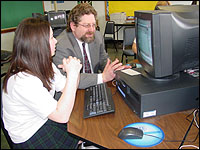Archives
CCR and Verizon bring bioinformatics to high schools
By ELLEN GOLDBAUM
Contributing Editor
A strategy in Buffalo aimed at stimulating awareness of careers in the life sciences, particularly bioinformatics, has spurred local teachers and UB's Center for Computational Research to develop several in-school programs to introduce bioinformatics to area high school students.

Russ Miller, CCR director,
discusses bioinformatics with Darcy Brown, a student in the "Next
Generation Scientists" project.
PHOTO: DONNA BUDNIEWSKI
The goal of the project is to introduce students to the emerging field of bioinformatics, where the life sciences meet computational science, in the hopes of inspiring—and retaining—some of Western New York's best and brightest young people.
"Western New York will be one of a handful of regions in the nation that soon will introduce a bioinformatics program into the high school curriculum," said Thomas Furlani, associate director of CCR and co-director of its high school bioinformatics project.
Called "Next Generation Scientists: Training for Students and Teachers," the project is funded by Verizon Corp.
"Verizon embraces UB's bioinformatics program as an economic-development engine that will improve job prospects and help keep our youth in Western New York," said Maureen Rasp-Glose, Verizon's director of community affairs. "Everyone wins with an educated workforce."
Furlani noted that the program provides students with a unique experience.
"The students in this program will be learning skills in computer science and biology that most high school students aren't exposed to in Western New York," said Furlani. "These skills will serve them very well in college if they pursue careers in the sciences, particularly bioinformatics, which is, of course, our objective."
"Next Generation Scientists" complements the effort, first proposed by Gov. George E. Pataki in 2001, to harness the strengths of universities and the private sector to create across New York State strategically targeted, high-technology centers of innovation, such as the UB Center of Excellence in Bioinformatics, aimed at spurring economic development and creating jobs.
To develop a skilled workforce that can leverage the region's existing strengths in the life sciences and bioinformatics, UB is developing several master's programs related to bioinformatics, and SUNY recently approved the university's first undergraduate degree program in this growing field.
Through after-school bioinformatics clubs, the CCR/Verizon pilot project so far has introduced more than a dozen highly motivated students at City Honors, Mt. St. Mary Academy and Orchard Park High School to the biology and chemistry of DNA and proteins, the Linux operating system, the basics of how to build small computer clusters and PERL, the basic programming language for bioinformatics.
At Mt. St. Mary, a Catholic high school for young women, the program has had the additional benefit of increasing access to technology skills for students who usually may not pursue them.
"The CCR/Verizon project has most certainly improved and broadened technology education at Mt. St. Mary," said Dawn Riggie, principal of the school. "In pursuing this project with CCR and Verizon, the fields of computer technology and bioinformatics have been opened up for our young women to learn about, and to play and experiment with. Our young women have learned a great deal and with that knowledge comes confidence and the belief that they can do more."
Furlani and E. Bruce Pitman, professor of mathematics and associate dean for research and sponsored programs in the College of Arts and Sciences, supervise CCR's annual summer computing workshops for high school students.
This past summer, several high school teachers involved in the project also attended CCR's annual workshop with their students as preparation for their involvement in "Next Generation Scientists."
Verizon has provided $50,000 to the project. HP donated a small computer cluster to each of the three schools, as well as a "mirror cluster" at CCR. Early work on the project also was funded in part by the National Science Foundation.
